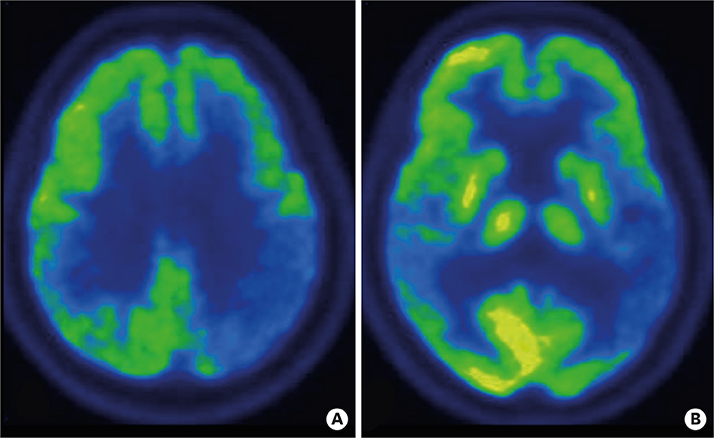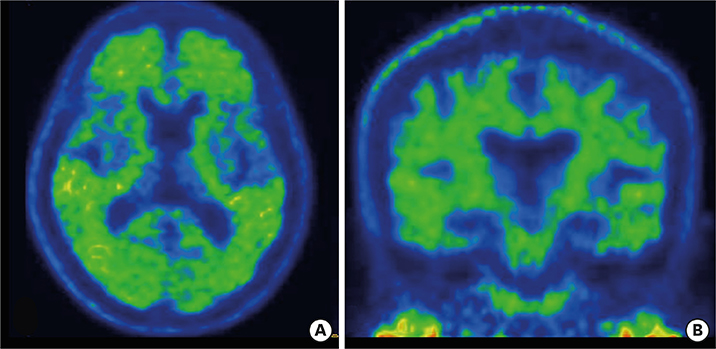Dement Neurocogn Disord.
2018 Jun;17(2):66-70. 10.12779/dnd.2018.17.2.66.
Early Onset Alzheimer's Disease Presenting as Logopenic Primary Progressive Aphasia
- Affiliations
-
- 1Seoul National University College of Medicine, Seoul, Korea.
- 2Department of Neurology, Seoul National University College of Medicine and Clinical Neuroscience Center, Seoul National University Bundang Hospital, Seongnam, Korea. neuroksy@snu.ac.kr
- 3Department of Neurology, Wonkwang University School of Medicine and Regional Cardiocerebrovascular Center, Iksan, Korea.
- KMID: 2442810
- DOI: http://doi.org/10.12779/dnd.2018.17.2.66
Abstract
- No abstract available.
Figure
Reference
-
1. Mesulam MM. Slowly progressive aphasia without generalized dementia. Ann Neurol. 1982; 11:592–598.
Article2. Gorno-Tempini ML, Brambati SM, Ginex V, Ogar J, Dronkers NF, Marcone A, et al. The logopenic/phonological variant of primary progressive aphasia. Neurology. 2008; 71:1227–1234.
Article3. Mesulam M, Wicklund A, Johnson N, Rogalski E, Léger GC, Rademaker A, et al. Alzheimer and frontotemporal pathology in subsets of primary progressive aphasia. Ann Neurol. 2008; 63:709–719.
Article4. Kang YW, Jang SM, Na DL. Seoul Neuropsychological Screening Battery-II. Seoul: Human Brain Research & Consulting Co.;2012.5. Skillbäck T, Farahmand BY, Rosén C, Mattsson N, Nägga K, Kilander L, et al. Cerebrospinal fluid tau and amyloid-β1-42 in patients with dementia. Brain. 2015; 138:2716–2731.
Article6. Hansson O, Zetterberg H, Buchhave P, Londos E, Blennow K, Minthon L. Association between CSF biomarkers and incipient Alzheimer's disease in patients with mild cognitive impairment: a follow-up study. Lancet Neurol. 2006; 5:228–234.
Article7. Matías-Guiu JA, Cabrera-Martín MN, Moreno-Ramos T, Valles-Salgado M, Fernandez-Matarrubia M, Carreras JL, et al. Amyloid and FDG-PET study of logopenic primary progressive aphasia: evidence for the existence of two subtypes. J Neurol. 2015; 262:1463–1472.
Article8. Teichmann M, Kas A, Boutet C, Ferrieux S, Nogues M, Samri D, et al. Deciphering logopenic primary progressive aphasia: a clinical, imaging and biomarker investigation. Brain. 2013; 136:3474–3488.
Article9. Henry ML, Gorno-Tempini ML. The logopenic variant of primary progressive aphasia. Curr Opin Neurol. 2010; 23:633–637.
Article10. Gorno-Tempini ML, Hillis AE, Weintraub S, Kertesz A, Mendez M, Cappa SF, et al. Classification of primary progressive aphasia and its variants. Neurology. 2011; 76:1006–1014.
Article
- Full Text Links
- Actions
-
Cited
- CITED
-
- Close
- Share
- Similar articles
-
- Logopenic Progressive Aphasia Revealing Positive Cerebrospinal Fluid Biomarkers for Alzheimer's Disease
- Pure Word Deafness in a Patient with Early-Onset Alzheimer's Disease: An Unusual Presentation
- Progressive Supranuclear Palsy Presenting as Primary Progressive Aphasia
- A Case of the Fluent Form of Primary Progressive Aphasia Presenting as Conduction Aphasia
- Primary Progressive Aphasia and the Left Hemisphere Language Network




